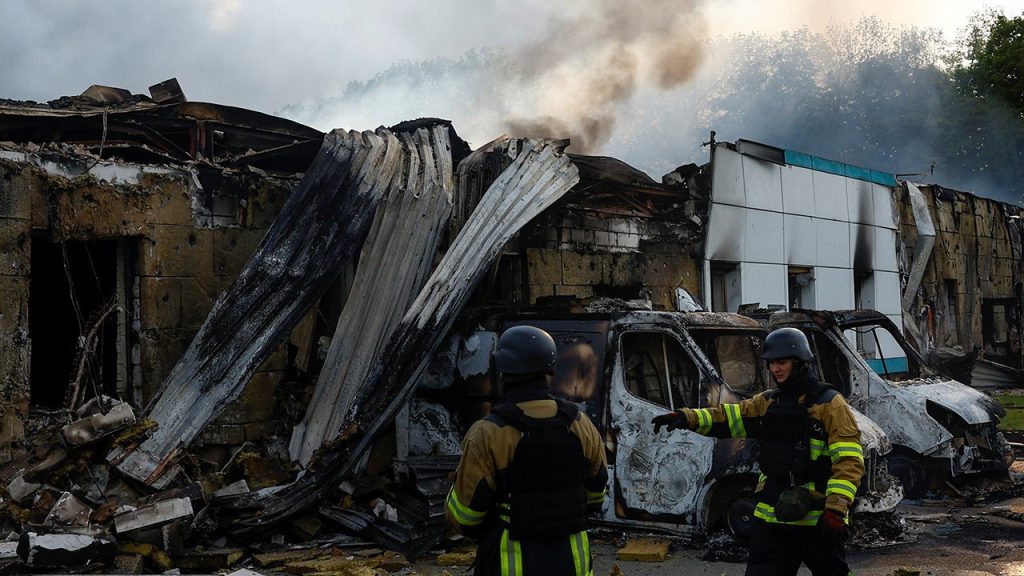In a significant escalation of hostilities, Russia has launched its largest drone attack on Ukraine since the onset of the war, targeting multiple regions including Kyiv, Dnipropetrovsk, and Donetsk. The attack involved 273 drones, marking a dramatic increase in military aggression just hours before a planned diplomatic call between President Donald Trump and President Vladimir Putin. Amid these developments, Ukrainian officials reported casualties and ongoing efforts for peace talks, highlighting the urgent need for negotiation amidst continuing violence.
| Article Subheadings |
|---|
| 1) Overview of the Drone Attack |
| 2) Casualties and Impact |
| 3) Diplomatic Efforts |
| 4) International Reactions |
| 5) Future Implications |
Overview of the Drone Attack
On **May 18**, in what is reported as the largest single drone attack since Russia’s full-scale invasion began in **February 2022**, the Russian military launched **273 drones** aimed at various strategic locations across Ukraine. **Ukraine’s air force** confirmed that **88 drones** were intercepted successfully, while **128 were lost**, which could be attributed to the use of electronic warfare techniques by Russian forces. This unprecedented level of aggression underscores a troubling escalation in the ongoing conflict, marked by apparent disregard for diplomatic overtures.
Casualties and Impact
Tragically, the drone assault has not only caused material damage but has also resulted in loss of life. **Mykola Kalashnyk**, the regional governor of Kyiv, reported that a **28-year-old woman** was killed and three other individuals, including a **4-year-old child**, were injured during this attack. Such incidents highlight the devastating human cost of the ongoing violence and serve as a stark reminder of the urgent necessity for immediate peace negotiations. As Ukrainian emergency services work tirelessly to address the damage caused by the drone strikes, the emotional and psychological toll on civilians grows increasingly concerning.
Diplomatic Efforts
Interestingly, this dramatic military action coincided with an announcement from President Trump, who stated he would be engaging in discussions with President Putin about the war. Addressing the pressing humanitarian crisis, Trump emphasized the need for a ceasefire to stop the **“bloodbath”** resulting in numerous casualties on both sides. His subsequent conversations, which will extend to include **President Zelenskyy** and NATO members, aim for a peaceful resolution to the ongoing conflict. **Zelenskyy**, for his part, reiterated Ukraine’s commitment to genuine diplomatic engagement, although expressing skepticism about Russia’s intentions in past negotiations.
International Reactions
In response to the surfacing tensions, reactions from global leaders are crucial in shaping the narrative and fostering an environment conducive to peace. The drone attack has drawn condemnation from various quarters, with officials expressing their solidarity with Ukraine. Furthermore, Vice President **JD Vance** and Secretary of State **Marco Rubio** engaged with Zelenskyy in Rome, where they discussed ongoing peace efforts, reinforcing the narrative that substantial international pressure must be exerted on Russia for a swift de-escalation. The international community is observing these developments closely, with widespread media coverage spotlighting the urgency for peace.
Future Implications
Looking forward, the implications of this drone attack are significant. The unprecedented scale of Russia’s military operations could force a shift in the tactical and strategic responses from Ukraine and its allies. The attack may inadvertently unify international sentiment against Russia, prompting further sanctions and diplomatic pressure. Additionally, the ongoing military aggression could redefine the parameters of future peace talks, with Ukraine emphasizing a full and unconditional ceasefire. The outcomes of these discussions, especially in light of recent drone attacks, remain uncertain yet fundamentally crucial for regional stability.
| No. | Key Points |
|---|---|
| 1 | Russia conducted its largest drone attack on Ukraine to date, involving 273 drones. |
| 2 | At least one fatality and injuries were reported as a direct result of the drone strikes. |
| 3 | President Trump indicated a willingness to negotiate a ceasefire during an upcoming call with President Putin. |
| 4 | International leaders are pressuring Russia to halt military operations and support a ceasefire. |
| 5 | The latest military actions could alter future diplomatic talks between Ukraine and Russia. |
Summary
The recent drone attack marks a significant escalation in the ongoing conflict in Ukraine, highlighting urgent humanitarian concerns and the pressing need for effective diplomatic engagement. The intersection of military aggression and political discussions raises critical questions about the future direction of the conflict. As world leaders assess the situation, the international community remains vigilant in its response, seeking pathways toward achieving a lasting resolution to the war.
Frequently Asked Questions
Question: What was the scale of the recent drone attack on Ukraine by Russia?
The recent drone attack by Russia involved a total of 273 drones, marking it as the largest single drone assault since the invasion began in February 2022.
Question: What were the reported consequences of the drone attack?
The attack resulted in at least one death and several injuries, including those of a young child, as reported by Ukrainian officials.
Question: What diplomatic efforts are being made to resolve the conflict?
President Trump is set to speak with President Putin about negotiating a ceasefire, aiming to halt ongoing violence. Ukrainian President Zelenskyy has expressed a willingness to engage in genuine diplomacy.


